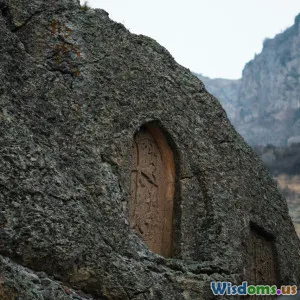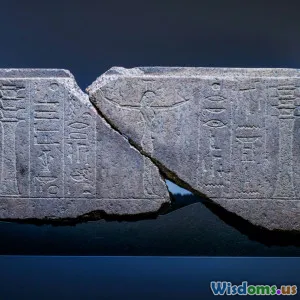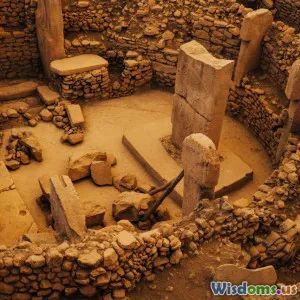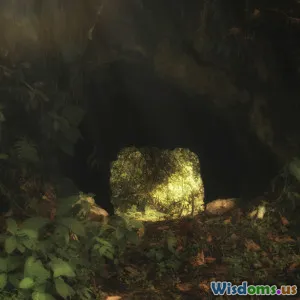
Did Giants Build The Strange Structures Of Baalbek
10 min read Explore the origins of Baalbek’s monumental stones and the legends of giants behind them. (0 Reviews)
Did Giants Build The Strange Structures Of Baalbek?
The ancient ruins of Baalbek, located in modern-day Lebanon, continue to baffle historians, archaeologists, and enthusiasts worldwide. Towering monoliths, including the world’s largest carved stones, raise captivating questions: How were these massive stones quarried, transported, and positioned with such precision thousands of years ago? Were they the product of extraordinary ancient engineering or the mythical handiwork of giants? This article explores the intrigue surrounding Baalbek's labyrinthine history, the impressive archaeological evidence of human ingenuity, and the captivating legends that have inspired speculation for centuries.
Introduction: The Enigma of Baalbek’s Massive Stones
Imagine stones weighing over a thousand tons arranged meticulously to create temple foundations that have stood the test of millennia. Baalbek’s site hosts some of the largest megaliths ever used in construction. The "Stone of the Pregnant Woman" alone tips scales at approximately 1,000 tons. Only a few ancient sites worldwide feature blocks of comparable size.
Such enormity, combined with the flawless precision and engineering required for their placement, sparks awe and mystery. Skeptics and believers alike pose the question: could these have been built solely by human civilizations of their time, or do these strange structures point toward legends of ancient giants?
This intersection between history, archaeology, mythology, and popular folklore offers a fertile ground to explore the truth behind the incredible structures of Baalbek.
The Historical and Archaeological Reality of Baalbek
Location and Significance
Baalbek—originally known as Heliopolis under Roman rule—sits on a plateau in Lebanon’s Beqaa Valley, boasting strategic and religious importance in antiquity. It functioned as a grand Roman temple complex dedicated to Jupiter, Venus, and Bacchus. Yet its history long predates the Romans, tracing back to Phoenician, Hellenistic, and possibly earlier civilizations.
Megalithic Stones of Baalbek
The most staggering feature of Baalbek is its dedication platform comprising megalithic walls known as the Trilithon. These walls contain three massive stones, each estimated to weigh between 750 to 900 tons. Even bigger stones—like the "Stone of the Pregnant Woman"—found in nearby quarries weigh well over 1,000 tons but were never moved from their original sites.
By comparison, the largest stones used in Egyptian pyramids weigh only about 70 tons. Baalbek's stones are thus among the heaviest ever lifted by any known ancient culture, a fact that fuels mystery and speculation.
Proven Engineering Expertise
Extensive studies by archaeologists and engineers reveal sophisticated techniques employed. The stones display precision-cut faces, tight joints without mortar, and alignment that could withstand natural forces such as earthquakes.
Scholars propose that the ancient builders had access to advanced tools, likely assisted by organized labor, ingenious leverage systems, and perhaps knowledge inherited through generations. Roman engineers, known for architectural prowess, possibly expanded on earlier foundations, providing the structures we see today.
In 2014, emeritus professor Thomas W. Powers published comprehensive research indicating Baalbek’s builders used timber sledges, rollers, and coils of rope suited to move enormous stones over short distances. Evidence from the nearby quarry also suggests that anisotropic rock properties were exploited to ease stone extraction.
Myths and Theories: The Legend of Giants
Cultural Context of Giants in Near Eastern Myths
Legends of giants permeate numerous ancient cultures. Biblical Nephilim, Mesopotamian Apkallu, and Greek Titans manifest the archetype of extraordinary beings endowed with exceptional strength and size. In regions like Lebanon, oral traditions, ancient texts, and folklore often intertwine historical monuments with supernatural explanations.
The Giant Hypothesis for Baalbek
Several fringe theories and speculative historians propose that giants constructed Baalbek's massive blocks. Proponents argue that the scale of stones and absence of clear historical records for their mobilization suggest a non-human explanation.
Books such as "The Giants of Baalbek" contend that myths should be taken literally, hypothesizing that forgotten races of colossal beings used advanced knowledge and power to build these strange structures.
Archaeological Counterarguments
Mainstream archaeologists reject these claims due to the lack of physical evidence supporting the existence of giants. All findings point toward skilled human workmanship instead. Existing signatures in tools, quarry marks, and discovered artifacts align with established historical contexts.
Nevertheless, these myths endure because they represent humanity’s attempt to rationalize extraordinary achievements using familiar symbolic frameworks.
Modern Exploration: Scientific Studies & Technological Insights
Advances in Archaeometry and Material Analysis
Modern technologies such as ground-penetrating radar, photogrammetry, and 3D laser scanning have allowed researchers to map Baalbek’s stones in exquisite detail without invasive digs.
Chemical composition analysis and fracture pattern studies provide clues on quarry processes and stone durability. The volcanic basalt beneath Baalbek may have contributed to stabilizing foundations, ensuring their longevity.
Experimental Archaeology and Reconstruction Efforts
Several teams worldwide undertook reconstructions based on ancient techniques. For example, attempts to recreate megalithic lifting methods show that with sufficient manpower, leverage systems, and planning, moving massive stones is plausible. These demonstrations challenge narratives that deny human capability entirely.
Furthermore, found historical accounts of Roman engineering, such as the writings of Vitruvius, describe mechanisms and building techniques relevant at Baalbek and other monumental sites.
Why Understanding Baalbek Matters
Appreciating Ancient Human Ingenuity
Baalbek stands not only as a physical monument but as a testament to the adaptability and engineering brilliance of human civilization thousands of years ago.
Recognizing these feats within their historical context helps elevate appreciation for ancient cultures beyond simplistic myths.
Preserving World Heritage
Today, Baalbek remains a UNESCO World Heritage site endangered by natural and human threats. Awareness encourages better conservation and global respect for cultural legacies.
Inspiring Scientific Curiosity and Cultural Respect
Exploring Baalbek’s mysteries draws interdisciplinary studies that unite archaeology, geology, anthropology, and mythology. It stimulates curiosity about humanity’s past and the extent of our ancestors' capabilities.
Conclusion: Giants, Myths, and Masters of Stone
While the allure of giants crafting Baalbek’s strange colossal stones captivates the imagination, current evidence strongly supports human ingenuity as the driving force behind these wonders. The legends serve as cultural metaphors, enriching our understanding of how ancient peoples perceived extraordinary achievements.
The stones of Baalbek provide fascinating insights into ancient technologies, long-lost building practices, and the symbolic narratives of survival shared across civilizations. Rather than dismissing these megaliths as divine or monstrous interventions, embracing the depth of the human story those stones represent allows us to connect with our shared heritage—reminding us what human determination can accomplish.
The ancient site of Baalbek invites all of us to marvel, investigate, and protect the monumental testament left from a time when giants of intellect, creativity, and skill walked the earth.
References:
- Powers, Thomas W. (2014). Engineering Marvels of Baalbek: An Ancient Hands-on Approach.
- Vitruvius, De Architectura.
- UNESCO World Heritage Centre. Baalbek - Heliopolis.
- Lehner, Mark. The Complete Pyramids.
Further Reading:
- "Giants, Folklore, and Archaeology: The Mythical Lens" by Dr. Helen Bell
- "Ancient Megalithic Engineering" by Michael Parker Pearson
Note: This article aims to balance myth and science by presenting facts alongside the cultural significance of legends related to Baalbek.
Rate the Post
User Reviews
Popular Posts



















